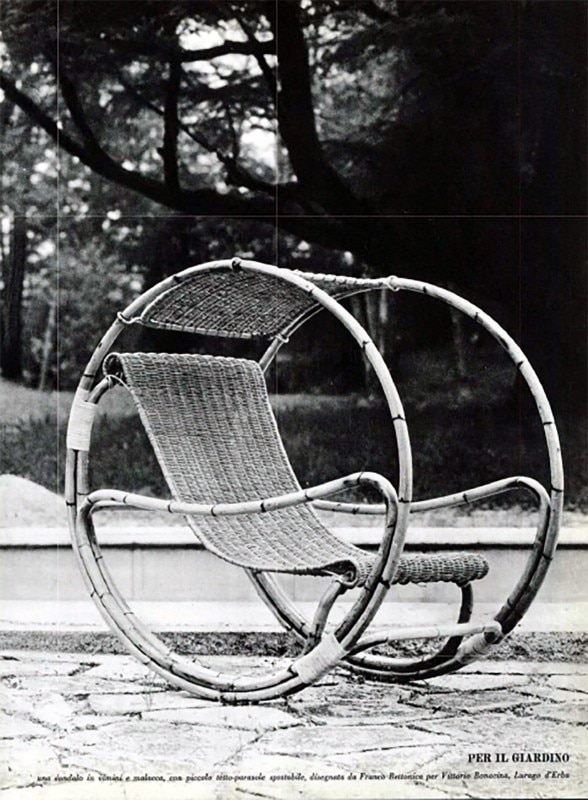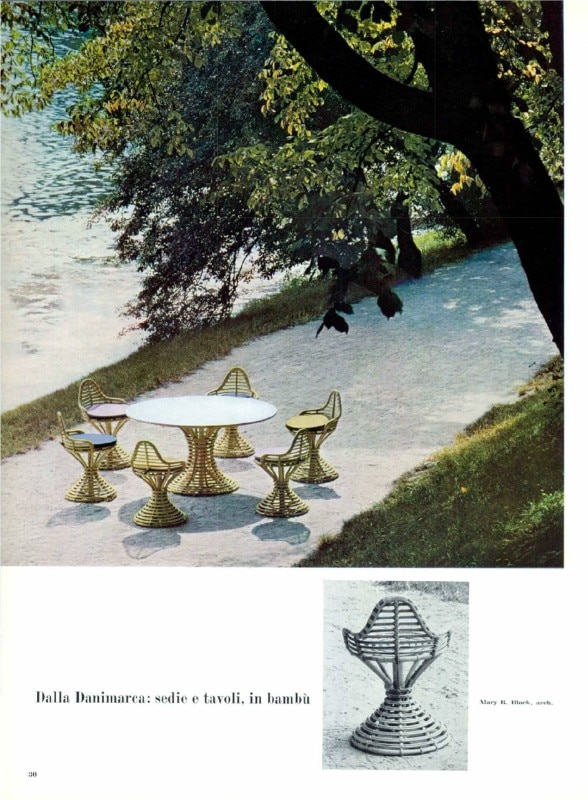Extendable weatherproof tables, poolside armchairs more comfortable than regal sofas, garden pergolas with integrated solar panels. Today, “outdoor furniture” is among the design products that most clearly reflect market demands. They seem to convey the need for domestic comfort even in open-air settings. These pieces are high-performing, accessorized, designer-branded, and, above all, undeniably “green” – bioclimatic, sustainable, photovoltaic, and eco-friendly.
While there is a push for hyper-functionality and high performance, the search for form still retains an appreciation for the past, revisiting and updating designs that belong to the history of outdoor furniture.
Among today’s pieces, there are clear references to anonymous design – such as the “Palissade” armchair by the Bouroullec brothers for Hay, a tribute to the metal chairs of Parisian gardens –, re-editions of rediscovered archival projects – like the elegant wooden armchair designed by Charlotte Perriand in 1947 for a hotel in the French Alps, now part of Cassina’s catalog in a water-repellent fabric –, or playful updates of iconic design pieces, seamlessly incorporating collaborations with fashion world. A perfect example is the “Locus Solus” collection by Gae Aulenti, reissued by Exteta in a special edition curated by the Parisian brand Jacquemus.
From the Domus archive, a journey through the history of outdoor furniture – moving from gardens to terraces, described by the editors as “among the most welcoming discoveries of modern architecture.” A journey that touches on poolside settings, Italian waterfronts, and Northern European beaches, while exploring ingenious solutions, experimental materials, and the most pop-inspired designs that extend beyond the domestic garden.
At the end of the 1930s, a colorful sequence of hand-drawn sketches offered Domus readers a collection of iron rod furniture “to decorate your terrace”: chairs, porch swings, and small sofas with fabric cushions – “revivals of styles that had become fashionable in the late 19th century.” How to modernize them? By painting them white or green. And just like that, modernity was achieved. (Domus 125, May 1938).
From the 1940s onwards, “materials and colors take away the weight of furniture”: straw, raffia and bamboo are used extensively for sofas, tables and rockers. The new furnishings required functionality and simplicity of form: “everything must become clear, crystal clear, without jaggedness or weight,” we read in the issue of August 1943, “without neglecting the search for harmonious and innovative forms. The photographs illustrate bentwood seats, straw armchairs that slide on wheels and small tables that can be carried away with one hand, like baskets: “thus lightened and refreshed, the piece of furniture often becomes a large toy” (Domus 188, August 1943).
Across the suggestions, there are also some proposals taken from the pages of foreign magazines, such as House and Garden: equipment for the sea and outdoor living, sun loungers, wicker sunbeds and “sailing sledges” for competing on the beaches. (Domus 163, July 1941).

Thus lightened and refreshed, the piece of furniture often becomes a large toy
Since the 1950s, the sceptre of outdoor furniture has been in the hands of Vittorio Bonacina: Domus constantly publishes the refined solutions in cane and bamboo of the craftsman from Lurago d’Elba, Italy, who in 1951 presents to the public what will be remembered in history as the “first chair without legs”, and an icon of Italian design: the Margherita wicker armchair, designed by Franco Albini. Bonacina’s extensive catalog also includes furniture in wicker and Indian cane designed by Franca Helg (Domus 358, September 1959), and a ‘round’ wicker rocking chair with a sunroof, designed by Franco Bettonica. (Domus 429, August 1965)

Interesting proposals also came from all over the world, such as those of the Japanese painter and designer Geniciro Inokuma, who in 1955 designed deckchairs in metal mesh and leather, a hammock in pneumatic fabric and a tea table in plywood (Domus 308, July 1955), while from Denmark the elegant solutions proposed by Mary Bloch stand out, with tables and chairs in bamboo and beautiful mobile cabins to shelter from the wind on the beaches of the North. The base is made of wicker and the walls of canvas, while two small windows and a frontal visor provide a view of the panorama. (Domus 373, December 1960)
The American company Mc Guyre, on the other hand, works on an innovative joint, solid and elastic: the elements of the folding armchairs in oak wood are held together by leather ligaments, knotted wet around the Philippine rattan, “a jungle liana, full hard and flexible.” (Domus 1965, 429)

In Italy, Roberto Mango’s formal experiments reach original results, in the wake of the American lesson, which has been able to refine practical, modular and stackable mass production. Mango designs practical outdoor chairs, transforming the nature of the chair, which becomes a cone resting on a metal support and thus transforms itself from a piece of furniture to “a fantastic and ephemeral object”, “a living part of lifestyle” (Domus 285, August 1954 ). A further development of the project is the “umbrella armchair”, made of a canvas cone and wooden slats: it opens, closes and is carried under the arm. (Domus 296, July 1954).

In August 1965, the garden furniture designed by Gae Aulenti made its first appearance, in curved and fire-painted steel tube, with removable upholstery: dining table, chairs, armchair and footstool, provided in the lively combinations, plum and yellow, hazelnut and white. They will become the pieces of the famous “Locus Solus” collection for Poltronova, orange and lemon yellow: in 1969, Alain Delon also sat on the chair of the Gae, in the film La Piscine, by Jacques Deray.
The proposals for life in the open air are increasingly agile and light, up to the French provocations of the Seventies. The Flying Carpet by Pierre Paulin, made of padded elements connected by hinges “when it does not fly it is a bed, also comfortable for resting after picnics”; after use, it rolls up in a Citroen Mehari, leaving for Eze-sur-Mer, on the French Riviera. The piece of furniture leaves the garden, and sets off for the beach. (Domus 490, September 1970).
The flying carpet by Pierre Cardin, when it does not fly, is a bed, also comfortable for resting after picnics
Opening image: The wicker swing chair by Franco Bettonica for Bonacina, with the movable sunshade roof, published in Domus 439, August 1965













